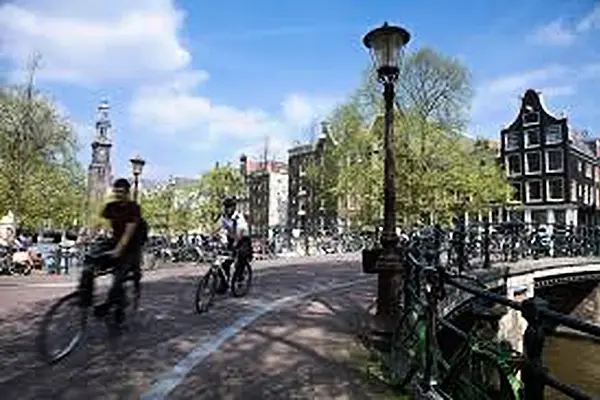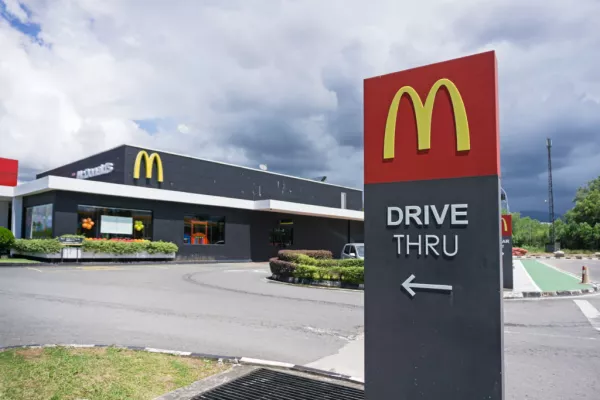It's home to Amsterdam’s most expensive hotel room (at $10,000/night), an exclusive members-only club and a revolving restaurant that serves up €120 ($131) tasting menus, along with panoramic views. But you won’t find this city’s newest star attraction along its quaint canals or in the notorious red light district.
Instead hop the ferry for the three-minute ride from Central Station across the harbor, to the up-and-coming Noord district, where a boxy, 1970s-era office building has been transformed into A’DAM Tower, a 24/7 entertainment destination of music, dance, and dining.
It’s an unlikely setting for such a creative endeavor: a 22-story high-rise that served as the headquarters of Royal Dutch Shell for nearly four decades. And though it stood just across the harbor from Amsterdam’s bustling Central Station, few had ever been inside—or even gotten close to it. The building was part of a 66-acre private waterfront complex of laboratories, offices, and staff housing that served the oil and gas giant—an area entirely off limits to the public since the mid-1960s.
Still, locals—and certainly tourists—didn’t much care to go to this northern district; with no restaurants, no bars—nothing but abandoned industrial sites and derelict shipyards to the west, and farther inland, quiet, working-class neighborhoods—there was little reason to cross the river.
All that began to change in 2003, when Shell decided its relocate its facilities upriver—opening up a huge swath of the waterfront to redevelopment. For years, city leaders debated what to do with the buildings and the surrounding land, much of it polluted by industrial waste. Ultimately they opted not to sell it to a single large developer and instead to rezone the area for both commercial and residential use—allowing growth to happen organically.
With the financial crisis of 2008, development stalled and the area languished for several additional years. It wasn’t until 2012 that people had a real reason to come to “the other side”—the game-changer was the EYE Film Museum and cinema, which lured tourists and locals alike with its futuristic, space-age design.
Today, ferries zip back and forth between Central Station and Noord, carrying thousands of people each day—on foot, bicycles, and scooters—to what is now considered one of the city’s trendiest neighborhoods. Beyond the EYE, there’s De Tolhuistuin, a music and performance space with a buzzy restaurant, THT, housed in what once was a Shell office pavilion. A youth hostel, ClinkNOORD, recently opened in a converted Shell laboratory. New offices cater to startup companies looking for an edgy, creative environment, while new condominiums entice young Amsterdammers with cheaper rents and bigger, more modern living spaces.
The Transformation of the Tower
After years of sitting empty, the centerpiece of the IJ waterfront revitalization is finally being realized.
“The city put the tower up for sale in 2009, but it was for sale only with a plan—and of the 37 ideas submitted, ours was the one chosen,” explains Duncan Stutterheim, a former event planner who—with three local entrepreneurs, nightclub owner Sander Groet, music agency founder Hans Brouwer and developer Eric-Jan de Rooij—secured the winning bid. They purchased the building for $10 million in October 2012.
“Our idea—since most of us had a background in the music industry—was to make music a central component in the building,” said Stutterheim. “And we knew it was important to create a 24-hour economy in Noord … to create an attraction outside the city center. … So we included a combination of elements for both visitors and locals: a hotel, restaurants, offices, a nightclub, entertainment areas.”
The ambitious renovation began in mid-2014 and has been making its debut in stages since May.
First came the Lookout—an open-air observation deck with 360-degree views of the city, harbor and beyond from the roof. The tourist-aimed venture features an enormous metal swingset that lets daredevils literally swing out over the edge of the building. In a nod to A’DAM’s music theme, the elevator ride to the Lookout offers a kind of mini-club experience, with a throbbing techno soundtrack and light show.
Where to Eat and Drink
Just below is MA’DAM, a casual dining spot, with a prix-fixe brasserie-style menu and floor-to-ceiling windows looking out over the River IJ. Evenings, the lights dim and the bar takes center stage, with trendy types sipping pricey cocktails as local DJs spin house music.
It’s a totally different vibe one floor down in the gourmet restaurant Moon; in its quiet, sophisticated dining room, chef Jaimie van Heije turns out intricate tasting menus ranging from the five-course, €60 Eclipse to the seven-course, €120 Full Moon, which includes wine pairings. The restaurant revolves once an hour, guaranteeing a different perspective of the city with each course. By the end of October, it will be open for lunch with an à la carte menu.
The 18th floor is home to a private, invitation-only club, Adam & Co., which counts musicians, DJs, and other creative types among its members. A kind of mini-Soho House, the cozy, understated space—with four large terraces and a piano tucked in one corner—also welcomes the occasional celebrity; the British band Muse recently stopped by after playing a show in Amsterdam.
And when floors 16 and 17—known as the Loft—aren’t being used for private events, they can be combined into one massive, 6,500-square-foot hotel room with two bedrooms, a private bar, and a sprawling living area with double-height ceilings and jaw-dropping vistas of the city below.
“The tower now draws about 3,000 people a day,” said Stutterheim, “but even more will come as the rest of the attractions open and we fully realize a 24-hour economy.”
That includes Shelter, an underground club set in the basement of the tower, reached by entering through a hatch in the ground just outside the building’s entrance. The venue, which can accommodate up to 800, hosts DJs spinning a progressive brand of techno house and dance music into the wee hours of the morning, Thursday through Sunday. It opened on Thursday, in time for the five-day Amsterdam Dance Event—the world’s biggest club festival.
Also coming online at the end of the month is the Butcher Social Club, the largest outlet of Amsterdam’s popular Shake Shack-like burger chain. Set in a glassy annex off the tower’s main lobby, the dual-level restaurant and bar—designed by New York Studio ICRAVE—is meant for fun, with ping pong, pinball machines, and colorful, original artwork. It will also be one of the city’s only 24-hour restaurants: From Thursday to Saturday, it will be open around the clock; from Sunday to Wednesday, from 7 a.m. until midnight. By day, it’s a comfortable spot to grab a coffee, hang out, and work on a laptop. Evenings, it will transform into a vibrant party scene with live DJs and creative cocktails.
The Hotel
The final piece of the tower’s puzzle opens at the end of the year—the four-star Sir Adam Hotel, the newest in the hip SIR boutique chain, which counts locations in Amsterdam’s trendy De Pijp neighborhood, Berlin, and soon, Hamburg and Ibiza. It will bring its brand of minimal chic to an area that has just a handful of hotels—mainly such big brands as Nh, Doubletree, and Ibis.
Sir Adam’s 108 rooms, spread over five floors, feature stripped concrete walls dotted with edgy rock posters and framed photographs of famous pop artists (Erykah Badu among them). The corner deluxe category, with views of the harbor, features headboard papered with movie posters from the 1970s. Other playful music touches: a record player (you can borrow LPs from the lobby) and, in every room, a Gibson guitar. (The company has offices in the tower.) Rates will start at €159.
“It’s really fun to see this building come alive, and to see how it will mingle with the changing neighborhood,” said Stutterheim, who was born and raised in Noord and compares it to another notable waterfront transformation. “For so long this was considered ‘that side’ of the water, like Brooklyn to Manhattan. But now there’s a real mixture of things going on and all sorts of different people coming here. … You can feel that finally something is really happening. Now there are reasons to leave the city center—and Noord has become a real destination."
News by Bloomberg, edited by hospitality Ireland









